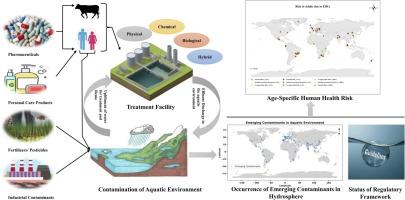Selected Emerging Contaminants in Water: Global Occurrence, Existing Treatment Technologies, Regulations and Associated Risk
IF 12.2
1区 环境科学与生态学
Q1 ENGINEERING, ENVIRONMENTAL
引用次数: 0
Abstract
Emerging contaminants (ECs) in aquatic environments have recently attracted the attention of researchers due to their ubiquitous occurrence and the potential risk they may pose to life. While advance analytical methods have improved global reporting in water matrices, additional information is needed to compile data on their occurrence, existing legislation, treatment technologies and associated human health risks. Therefore, the present study provides an overview of the occurrence of selected ECs, including personal care product, antibiotics, NSAIDs, EDCs and psychiatric drugs, the existing regulatory framework and their toxicological effects on human health. The water matrices under review are the treated wastewater, surface water, groundwater and, in a few cases, drinking water. The study also highlights different treatment technologies available, and evaluates their performance based on the removal efficiency for different classes of ECs. For removal of almost all ECs considered, ozonation integrated with gamma radiation was reported highly efficient. Risk analysis was also performed for selected ECs including diclofenac, ibuprofen, naproxen, carbamazepine, estrone, 17 β-estradiol, bisphenol A, sulfamethoxazole, erythromycin and triclosan. The human health risk analysis indicated the highest number of locations with potential risk due to the EDCs, with South America, Europe and Asia having multiple risks due to estrone and Bisphenol A. The results of this study will give a better insight into the current situation of ECs in the global water matrices, the performance assessment of treatment technologies and the risk analysis will describe the need for more robust regulatory structures around the world to prevent the occurrence of such contaminants in the aquatic environment.Environmental Implications
The research underscores the pressing environmental implications of emerging contaminants (ECs) in aquatic systems. The compilation of global data on the occurrence of ECs provides insight into their extensive presence and facilitates the identification of regions and water matrices most affected. This information can inform targeted monitoring and management strategies in areas with raised contamination levels. The study also emphasises need for more generalised and robust regulatory framework to mitigate the presence of emerging contaminants in environmental water. Moreover, with the risk assessment the study also supports the development of targeted risk management strategies.

选定的水中新污染物:全球发生率、现有处理技术、法规和相关风险
水生环境中的新出现污染物(ECs)最近引起了研究人员的关注,因为它们无处不在,而且可能对生命构成潜在风险。虽然先进的分析方法改善了全球对水基质中新出现污染物的报告,但仍需要更多信息来汇集有关其出现、现行法规、处理技术和相关人类健康风险的数据。因此,本研究概述了部分氨基甲酸乙酯的出现情况,包括个人护理产品、抗生素、非甾体抗炎药、易致癌物和精神药物、现行监管框架及其对人类健康的毒理影响。审查的水基质包括经处理的废水、地表水和地下水,少数情况下还包括饮用水。研究还重点介绍了现有的各种处理技术,并根据不同类别氨基甲酸乙酯的去除效率评估了这些技术的性能。据报告,在去除几乎所有氨基甲酸乙酯方面,结合伽马射线的臭氧处理技术效率很高。此外,还对选定的氨基甲酸乙酯进行了风险分析,包括双氯芬酸、布洛芬、萘普 生、卡马西平、雌酮、17 β-雌二醇、双酚 A、磺胺甲噁唑、红霉素和三氯生。人类健康风险分析表明,存在 EDCs 潜在风险的地区数量最多,其中南美洲、欧洲和亚洲存在雌酮和双酚 A 的多重风险。这项研究的结果将使人们更深入地了解全球水基质中ECs的现状、处理技术的性能评估以及风险分析,从而说明世界各地需要更健全的监管结构,以防止水生环境中出现此类污染物。通过汇编有关 ECs 出现情况的全球数据,可以深入了解 ECs 的广泛存在,并有助于确定受影响最严重的区域和水基质。这些信息可为污染水平较高地区的针对性监测和管理策略提供依据。研究还强调,有必要建立更广泛、更健全的监管框架,以减少环境水体中新出现的污染物。此外,通过风险评估,该研究还有助于制定有针对性的风险管理战略。
本文章由计算机程序翻译,如有差异,请以英文原文为准。
求助全文
约1分钟内获得全文
求助全文
来源期刊

Journal of Hazardous Materials
工程技术-工程:环境
CiteScore
25.40
自引率
5.90%
发文量
3059
审稿时长
58 days
期刊介绍:
The Journal of Hazardous Materials serves as a global platform for promoting cutting-edge research in the field of Environmental Science and Engineering. Our publication features a wide range of articles, including full-length research papers, review articles, and perspectives, with the aim of enhancing our understanding of the dangers and risks associated with various materials concerning public health and the environment. It is important to note that the term "environmental contaminants" refers specifically to substances that pose hazardous effects through contamination, while excluding those that do not have such impacts on the environment or human health. Moreover, we emphasize the distinction between wastes and hazardous materials in order to provide further clarity on the scope of the journal. We have a keen interest in exploring specific compounds and microbial agents that have adverse effects on the environment.
 求助内容:
求助内容: 应助结果提醒方式:
应助结果提醒方式:


